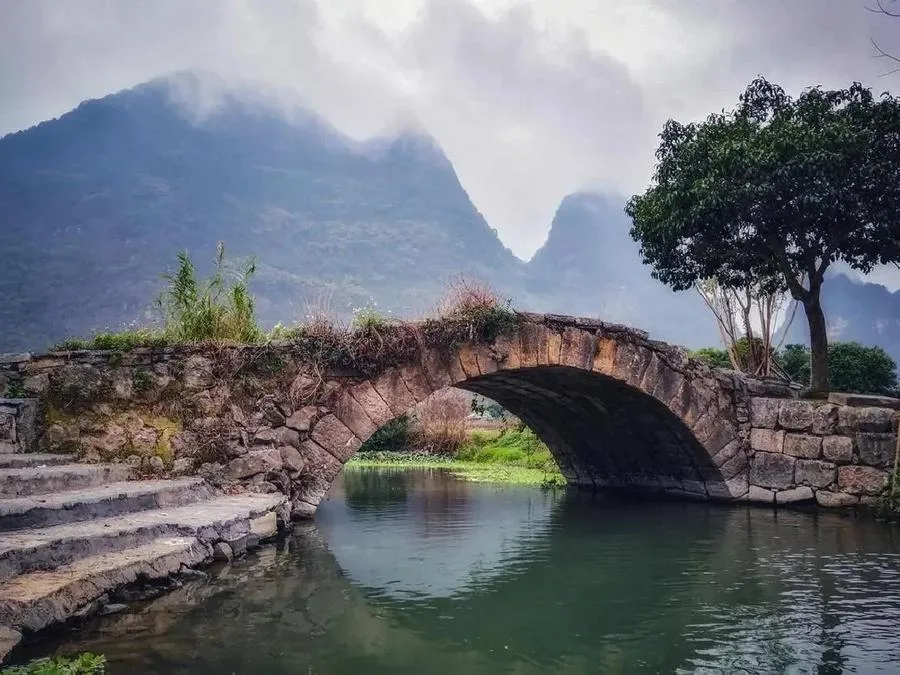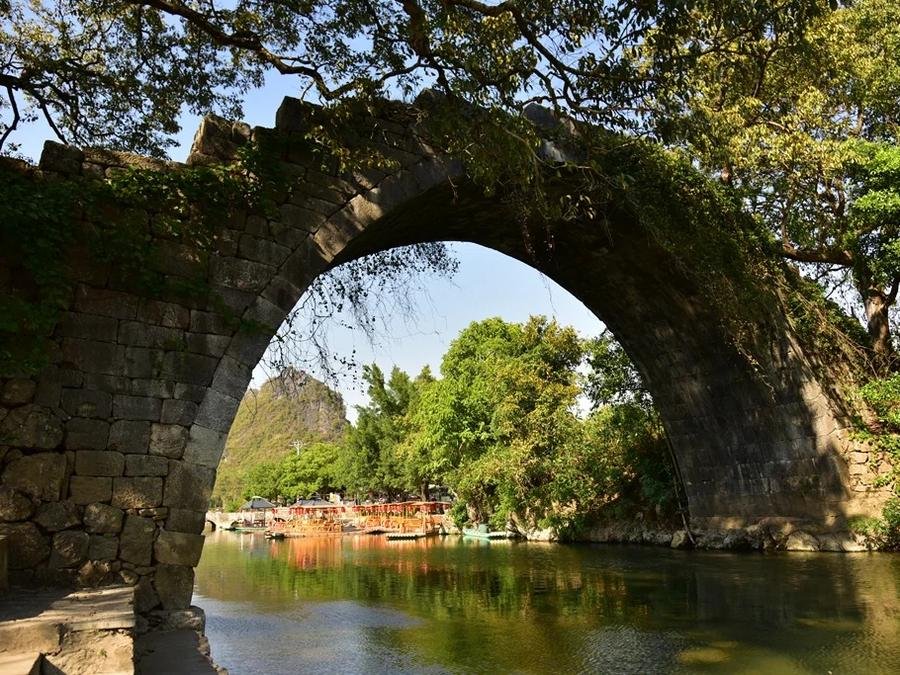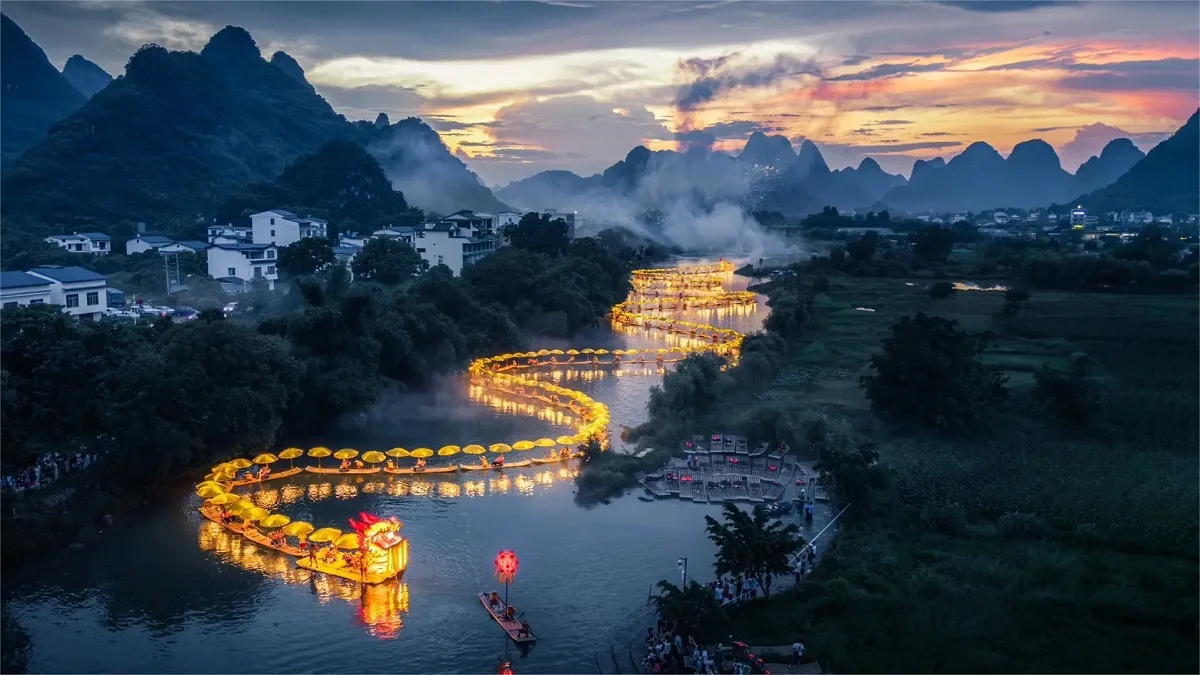The Yulong River (遇龙河, Meet Dragon River), historically known as Anle Shui, is named after the famous Yulong Bridge located midstream. Spanning 43.5 kilometers, it is often referred to as the “Little Li River.” From Yulong Bridge to Gongnong Bridge, the river stretches 15.36 kilometers, with a width of 38 to 61 meters and a depth of 0.5 to 2 meters. The water remains clear throughout the year, flowing gently and creating a serene atmosphere. There are 28 weirs and over a hundred scenic spots along this section. On sunny days, the river’s clarity mirrors the surroundings, while rainy days shroud the peaks in mist, offering picturesque views reminiscent of traditional Chinese landscape paintings.
The Yulong River area is untouched by modern construction, artificial embellishments, or urban noise, preserving its original, natural, and rustic beauty. It stands as the largest natural landscape garden in the Guilin region.
The best time to visit and experience bamboo rafting on the Yulong River is from April to October. Drifting along the river on a bamboo raft provides an enjoyable experience, with scenic landscapes on both sides. The docks include Jinlong Bridge, Yulong Bridge, Jiuxian, Jima, Shui’e Di, Gongnong Bridge, and Wanjing. The recommended route is the upper section of the river from Jinlong Bridge to Jiuxian, which takes about 1.5 hours. This route passes by Yulong Bridge and Xiniu Pond. The lower section (Chaoyang/Jima to Gongnong Bridge) is more commonly frequented by group tourists.
Table of Contents
- Basic Information
- Location and Transportation
- Highlights of Yulong River
- Vlog about Yulong River
- Guide to the Bamboo Rafting
- Other Notable Attractions in Yangshuo
Basic Information
| Estimated Length of Tour | Half a day |
| Ticket Price | Depend on the specific section and season |
| Opening Hours | 8.00 – 17.00; Last admission: 16.30 |
| Telephone Number | 0086-0773-8883118 |
Location and Transportation
The Yulong River spans 43.5 kilometers, flowing through Yangshuo County and passing through five townships: Jinbao, Putao, Baisha, Yangshuo, and Gaotian, as well as over 20 villages. To get there, you can choose one of the following ways:
By Minibus: Take a minibus from the Yangshuo Bus Station to Jinbao (金宝) and get off at Jinlong Bridge (金龙桥) to reach the pier.
By Shuttle Bus: Take a shuttle bus from the Yangshuo Bus Station to Guilin, alight at Baisha Town, and then take a tricycle to Yulong Bridge.
Highlights of Yulong River
Yulong Bridge (遇龙桥)

Yulong Bridge is a stone arch bridge spanning the Yulong River, situated next to Yulong Village in Baisha Town. Built during the Ming Dynasty, the bridge is 60 meters long, 5 meters wide, and 9 meters high, with an 18-meter arch span. Constructed entirely of stone without using any mortar, it has stood the test of time for centuries without damage, marking it as a key cultural relic in Yangshuo County. The bridge presents an imposing and magnificent structure, with ivy creeping up its sides, giving it an ancient and charming appearance. Under the bridge flows the gentle river, where villagers have fetched water and done laundry for generations. Witness to countless changes over the centuries, Yulong Bridge remains as solid as ever. It also bears historical significance for the local community, commemorating the heroic resistance against Japanese invaders by the residents of Zhujia Village (also known as Tianzuo Village) across the bridge, who defended their home for nine months. Although the memorial tablet was destroyed during the Cultural Revolution and thrown into the river, the government retrieved the lower half of the tablet in 1987, restored it, and placed it back on the bridge for visitors to remember the past.
Xiangui Bridge (仙桂桥)

Xiangui Bridge, another stone arch bridge on a tributary of the Yulong River, is the oldest stone arch bridge in Guangxi Zhuang Autonomous Region. Standing 2.2 meters high, 26 meters long, and 4 meters wide, it was constructed in the fifth year of the Song Dynasty’s Xuanhe era (1123 AD). The bridge’s structure is unique, utilizing a rare parallel brick method with nine sets of arch stones, comprising 281 stones in total. Despite over 800 years of weathering and flooding, Xiangui Bridge has remained intact, showcasing the advanced engineering skills of its builders.
Fuli Bridge (富里桥)

Located 500 meters upstream from Yulong Bridge, Fuli Bridge is a single-arch stone structure built during the Yongle era of the Ming Dynasty. The bridge is 30 meters long, 5 meters wide, and 10 meters high, and is considered one of the three ancient bridges in Yangshuo. Both ends of the bridge are marked by ancient trees that match the bridge in length and height. From a distance, the bridge’s arch and its reflection in the water resemble a full moon. Standing at the bridgehead, one can enjoy the scenic view of the surrounding green hills and clear waters, embodying the picturesque landscapes typical of southern China.
Zhouzhai Village (周寨)

Zhouzhai is a small village notable for the clear waters of the Yulong River flowing at its entrance and a high-arched stone bridge, less than ten meters wide, spanning the river. This bridge, also known as Wangfu Bridge, is over 200 years old and is the first ancient stone bridge on the Yulong River. Although the bridge surface has worn thin, the semicircular arch remains intact, showcasing the solid craftsmanship of ancient builders. Beneath the bridge, local women can be seen using traditional methods to wash clothes, scrubbing and pounding them against stones. Finding Zhouzhai means discovering the upper reaches of the Yulong River.
Legend Related to the Name

According to legend, a dragon from the East Sea once toured this area. Mesmerized by the breathtaking scenery, which made the East Sea seem dull in comparison, the dragon decided to stay. It would surface at night to admire the beautiful landscape and occasionally come out during the day, much to the surprise of the villagers, leading to the naming of the river as Yulong River (“Encountering Dragon River”). Another version of the story suggests that the river was originally named Anle Shui (“Peaceful Water”) but was later renamed Yulong River after the famous Yulong Bridge located midstream.
Vlog about Yulong River
Guide to the Bamboo Rafting
Jinlong Bridge to Jiuxian (One-way), 2-person raft
- Route Length: 6KM
- Duration: Approximately 90 minutes
- Cost: 320 RMB per raft
- Highlights: This popular route is the most scenic and comprehensive, featuring nine dams. It offers an immersive experience, perfect for those looking for an in-depth adventure and willing to spend a bit more. Highly recommended for enthusiasts.
Shui’e Di to Gongnong Bridge (One-way), 2-person raft
- Route Length: 3KM
- Duration: Approximately 40 minutes
- Cost: 200 RMB per raft
- Highlights: A condensed version of the rafting experience, with fewer scenic spots than route 1, but still quite beautiful and cost-effective. It includes four dams and is conveniently located near West Street, just 10 minutes away. Ideal for those wanting a quick bamboo rafting experience and some photos. Recommended for those with limited time and budget.
- Note: Keep your bamboo raft ticket; it allows a free return trip by electric sightseeing car to the starting point.
Fuli Bridge to Sancha Kou (Round-trip), 4-person raft
- Route Length: 2KM
- Duration: Approximately 40 minutes
- Cost: 358 RMB per raft
- Highlights: A leisurely route with no dams, starting and ending at the same dock, making it suitable for self-driving tourists. The river is calm, perfect for a relaxing trip or a family outing. Ideal for those who prefer not to get wet.
Jima to Gongnong Bridge (One-way), 2-person raft
- Route Length: 6KM
- Duration: Approximately 90 minutes
- Cost: 320 RMB per raft
- Highlights: This route is great for nature lovers who want to take their time and enjoy the scenery, including some dam experiences.
Jiuxian to Xiangui Bridge (Round-trip), 2-person raft
- Route Length: 2.5KM
- Duration: Approximately 40 minutes
- Cost: 180 RMB per raft
- Highlights: A less crowded, upstream route, perfect for avoiding long queues during peak tourist seasons.
Yulong Bridge to Xiniu Pond (Round-trip), 2-person raft
- Route Length: 2.5KM
- Duration: Approximately 40 minutes
- Cost: 180 RMB per raft
- Highlights: This affordable and moderately timed route offers a good balance of price and experience.
Wanjing Dock Leisure Rafting, 5-8 person raft (minimum charge for 5 people)
- Route Length: Approximately 2KM
- Duration: Approximately 40 minutes
- Cost: 45 RMB per person
- Highlights: A leisurely rafting option, suitable for families with elderly and young children. Water guns are allowed. This is the only section of the Yulong River where children under one meter can raft.
Practical Tips
- Pricing: Rafts are charged per raft, not per person. Children require a full ticket.
- Weight Limit: For 2-person rafts, those weighing over 200 jin (100 kg) must use a separate raft.
- Age and Height Restrictions: Seniors over 70 and children under one meter cannot ride 2-person rafts with dams.
- Footwear: Wear sandals, and protect your phone during rafting. You can hang bags on the back of the chair, but avoid bringing too much.
- Sun Protection: Remember to apply sunscreen.
- Tipping: Tipping is optional, but generally appreciated. Tipping between 20-50 RMB per raft can result in better service and more photo opportunities at scenic spots.









I arrived at the Shui’e Di Dock (水厄底码头) around 9:30 AM, and there was no line at all. Most of the raft operators were sitting on the bamboo rafts resting. Plus, I was able to enter directly by scanning my ID card, so no physical ticket was required. The scenery along the Yulong River was absolutely stunning; it felt like I was traveling in a painting. The 200 yuan was well worth it!
On Sunday, March 23rd, I rode an electric bike to Xiatang Wharf (夏棠码头) to take a bamboo raft ride. Near Xiatang Wharf, there were vast fields of blooming rapeseed flowers, lush and thriving. I arrived around ten in the morning and waited to share a boat with others, which didn’t take long so there was no need to queue. The weather was pleasant, sunny but not too hot, with a slight cool breeze that felt really nice. There weren’t many… Read more »
Route: Jima Wharf — Shuiedi Wharf — Comprehensive Wharf Ticket Price: 320 for a double raft Duration: Approximately 70 minutes Ticket Check Time: 10:00 AM – 12:00 PM Ticket Purchase Time: Tickets can be bought on the WeChat mini-program the evening before at 8 PM. It’s less crowded now, so buying tickets isn’t difficult. The scenery between 10 AM and just after 11 AM is beautiful. The rafting journety covers a distance of 6 km with 9 dams along the… Read more »
The bamboo raft drifting along the Yulong River from Jima Dock to Gongnong Bridge is absolutely beautiful throughout the entire journey. The rapids are quite thrilling, making it an incredibly worthwhile experience.
Drifting on the Yulong River Heals My Unhappiness I chose to go from the Water Buffer Dock (水厄底码头) to the Comprehensive Dock (综合码头). There were very few people, so I didn’t have to stand in line; I bought my ticket online and just scanned the code. Although it was the dry season and the water level was quite low, the scenery of the mountains and rivers was extremely beautiful. My mood instantly lifted. The entire journey lasted over 30 minutes.… Read more »
We chose the section from Jindong Bridge to Jiuxian Wharf. Originally, we planned to go to Shui’e Di, but ended up taking the wrong path and opted for this route instead. However, it turned out to be quite fun! This section has the most dams, with a total of nine, and the journey is the longest at one and a half hours. The boatman paddled at a leisurely pace, making it perfect for taking photos. We rode there on an… Read more »